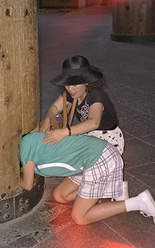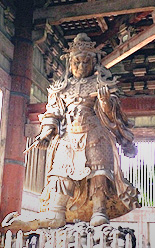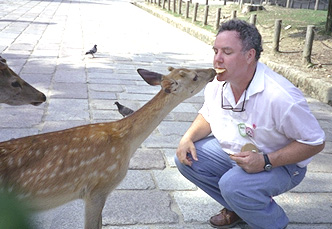
Bruce "Tog" Tognazzini.
|
|
Japan on $1000 per Day
Day 12: Where the Deer and the Bon Jovi PlayOff to Nara by train and tour bus. Nara was the capital of Japan even before Kyoto, from 710 to 784 AD. This was a transitional era, when Japan imported freely from China its music, culture, and religion. We had come to see Todaiji Temple, the Eastern terminus of the Silk Road that stretched all the way from Europe, and even Europe’s influence can be found in its buildings and statues. Todaiji Temple’s main structure is the largest wooden building in the world. It needs to be: it houses the largest Budda in the world, one that puts that Daibutsu wanna-be in Kamakura to shame.
While Julie slid through with ease, I became firmly wedged inside the column and had to be extricated by having two people yank on my legs until I popped back out like a cork from a champagne bottle. The Japanese found this very amusing. I continue to find it impossible to understand their strange Eastern sense of humor. On our way out of the temple, we passed the inevitable gift shop, followed hard by a group of monks flogging roofing tiles. It seems that every 80 to 100 years, the old tiles wear out, so they sell, for $10 a piece to the tourists, rights to sign their names on the new tiles that will soon grace the building. (This scam probably also made its way down the old Silk Road, since the Christians caught onto it years ago.) We immediately signed up, brushing our names, copied from our Japanese Katakana business cards, onto the dark blue tile. We then walked back into the blinding light of the vast and serene courtyard that lay before the temple, imagining all the solemn rites and rituals that had played out there over the centuries. It was only afterward that we learned that Bob Dillon, Joni Collins, and Bon Jovi played out there over a very loud PA system only the week before. The Japanese have no problem freely mixing the sacred with the secular, particularly if it keeps the money flowing in. Passing through the gates, we found ourselves in the Nara Deer Park, home to 1000 tame deer, each with their own Genuine Tame Deer Food merchants. The ritual was simple: You handed the merchant all your money, the merchant handed you some flat, 3" disks that tasted suspiciously like compressed rice cakes, and fifteen or twenty deer mugged you. I soon tired of feeding them from my hand and knelt down to let them eat a wafer I was holding between my teeth.
This turned out to be very confusing to the deer, who kept looking for the food in my hand. One deer finally figured it out, however, and we entered into a contest to see who could eat the largest portion of the disk. I won. That night, we popped over to the Ashiya Steak House and Gallery for a nice little steak dinner. Julie had the 5.5 ounce fillet, while I went for the heartier 12 ounce tenderloin. Our dinner included a small salad for a starter and a sliver of cheesecake for desert. No wine, no liquor, no nothing. The bill came to $392.00. No exaggeration. What’s more, it was worth every penny. The Japanese didn’t even eat meat until a little over 150 years ago, but like everything else they touch, once they got into it, they really got into it. Not content with feeding their cattle the usual grasses and grains, they discovered that beer-feeding gave their beef a superlative flavor. They then turned their attention to tenderness, discovering that daily hand-massages would do the trick. (I tried to sign up for the program myself. Being fed beer and receiving massages all day sounded like a pretty good tradeoff to me, but it turned out I wasn’t qualified. You have to be able to fit through that stupid hole back in Nara or they won’t take you.) The result of all this care is Kobe beef, from Kobe, Japan, easily the finest beef in the world. I had them serve us a small portion of my steak as sashimi, just so we could appreciate the true flavor of the beef. The meat is shot with fat, and has a rich flavor that reflects the taste of hops the steer had so enjoyed. They then cooked the balance. Ashiya’s beef is served semi-American style: they put salt on it, instead of soy sauce. It is sliced up and cooked quickly on a hot grill Tepanyaki style, a la Benihana, but without the USA fanfare of knives spinning through the air. All is served medium-rare, except for the last bit containing a chunk of fat. It was sliced as thin as bacon and similarly fried until crisp. No words can give justice to how good this all tasted, except to reiterate that it was worth the $392.00.
My wife and I enjoy the New Otani, centered in Los Angeles's Japan Town, as a great weekend getaway, providing the nearest thing to the true Japanese experience you're likely to find this side of Tokyo. Half-price rooms are available to travelersadvantage members. After the main course, we were led through the 150 year old house to the upstairs art gallery, where we took our tea and desert. Much of the gallery was given over to the usual lineup of famous people who have landed at Ashiya at one time or another. One entire shelf was filled with scrapbooks containing letters sent by the American ex-patriot owner of Ashiya to various world leaders over the last 30 years, offering his views on Japan, America, and the World Situation. On the page opposite each letter, proudly displayed, was its form-letter reply. Upon serving dessert, the waiter kindly offered to take our picture, after surreptitiously sliding a small card bearing the words, "ASHIYA RESTAURANT, KYOTO" onto the table in front of us. He then acceded to having me take a picture of my bride and him, generously displaying the 360 point type on his left sleeve, reading, "ASHIYA RESTAURANT, KYOTO." When the meal was over and he was leading us to our cab, he once again generously offered to snap another shot outside the photogenic entrance to the place, maneuvering us into just the right spot. There we are, just the three of us: Julie, me, and a four-foot tall Japanese lantern, gaily festooned with the words, "ASHIYA RESTAURANT, KYOTO." Now, what was the name of that place again? Previously: Day 11: Castles in the Sky Next month: Day 13: Doom |


